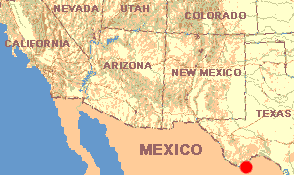 February 28, 1988
February 28, 1988TEXAS: Brewster County
K-Bar Campsite in Big Ben National Park; elevation about 3000 feet.
 February 28, 1988
February 28, 1988My Grandmother Taylor in Kentucky tends to make up words as she needs them and to resurrect old-time ones that everyone else has forgotten. For her the word slumgullion means "a haphazard mixture of things." She can't recall whether the word is made-up or an old one. Whichever pedigree the term has, here I mean to offer miscellaneous notes that don't fit elsewhere.
![]() ITEM: ANOTHER PECCARY STORY
ITEM: ANOTHER PECCARY STORY
On my last day at K-Bar a young man from Minnesota drops by. Taking a break from my
typing, I listen to his peccary story. Late yesterday afternoon as he was driving on the
main highway near Park Headquarters he came upon a small herd of peccaries. He stopped,
stepped outside, and began tossing pieces of tortilla to them. As the peccaries ate, he
threw the scraps nearer. Eventually the largest peccary took a tortilla from his hand. Of
course this was pretty dumb, for what if the next time the peccary meets a human it
remembers its earlier tortilla picnic, approaches the human, the human panics and does
something to unnerve the pigs, and then -- as Don Antonio in Guatemala suggested they
might -- the peccary runs the wrong way, slashing its sharp tusks back and forth?
![]() ITEM: A ROCK SQUIRREL
ITEM: A ROCK SQUIRREL
The other day in a rocky gulch behind park headquarters I spotted a Rock
Squirrel holding motionless atop a large boulder as I walked by. Rock
squirrels look like regular park squirrels except that they are entirely gray instead of
having white underparts, and they don't hold their tails above their backs. Though Rock
Squirrels usually create dens beneath boulders, they are fine tree-climbers when trees are
present. This species is one of the few mammals in these parts active during the day.
![]() ITEM: CHEWED-UP CACTI AND LECHUGUILLA LEAVES
ITEM: CHEWED-UP CACTI AND LECHUGUILLA LEAVES
Often I find patches of very spiny cacti that have been chewed on by large
herbivores, probably either mule deer or peccaries. For
me one of the greatest mysteries in this desert is how animals can eat spiny cacti without
damaging their lips, tongues and intestines. In several peccary scats I've found glochids
and a few spines. Similarly, very often I find stiff leaves and even entire plants of the
leg- mutilating Lechuguilla lying on the ground, chewed up. After
examining footprints around lechuguilla-eating sites for three weeks, I'm satisfied that
it's peccaries chewing them. The long leaves are not actually consumed, but rather it
appears that the peccary just chews on the leaf's lower half until it's no longer juicy. A
Park-Service, self-guiding, nature-trail leaflet declares that deer eat lechuguilla
flower-stalks and birds eat lechuguilla seeds. Prehistoric Indians roasted lechuguilla
stalks and some Mexicans still make soap from its roots, and twine and rope from its
fibers.
![]() ITEM: THE DESERT SKY
ITEM: THE DESERT SKY
Because of the absence of cloud cover and humidity in the air, at night the desert sky is
almost unbearably clear and deep. During my visit Jupiter and Venus are quite close to one
another. Using only 10 x 50 binoculars I can see four of Jupiter's moons. If the day sky
is occupied by white, puffy cumulus clouds, the most distant cloud bottoms merge with the
desert horizon. Farther east, because the air contains so much moisture, such near-horizon
clouds usually fade into the horizon's milky haziness. This desert sky inspires a person
with expansive feelings. At Park Headquarters I heard a native Westerner who'd just
returned from the East exclaim, "Oh, how wonderful to be back where I can stretch my
eyes... !"